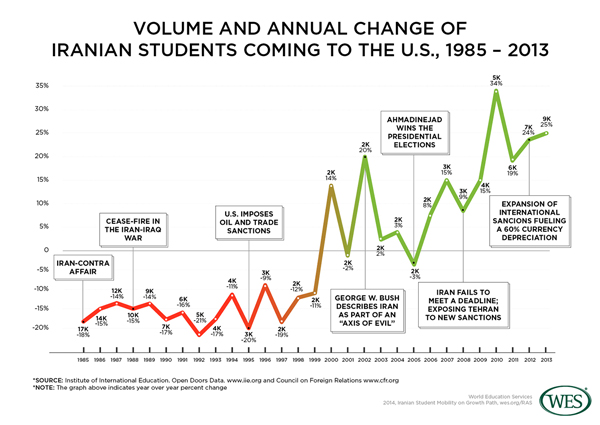Alejandro Ortiz, Research & Advisory Services, WES
According to the Institute of International Education’s most recent Open Doors report (2013) [1], Iran ranks as the 15th largest source of international students in the U.S. This position has been driven most recently by a 25 percent increase in overall student numbers last year versus 2012, a growth rate higher than that of China (21%). During the five-year period from 2008 to 2013, the number of Iranian students in the U.S. has almost tripled, from 3,060 in 2008 to 8,744 in 2013.
According to the UN Population Fund [3], Iran’s youth population increased dramatically during the latter half of the 20th century, and it is projected that by 2015 half of its population will be younger than 29 [4]. The entry of post-revolution baby boomers [5] into the school system at the primary and secondary levels from 1984 has placed heavy demands on Iran’s educational system [6]. However, capacity has grown significantly [7] to meet demand. This has been especially evident in the private sector, with rapid expansion in the number of private institutions of higher education, which educate over half of Iran’s 3.4 million tertiary-level students [8]. Nonetheless, competition for places at Iran’s best universities remains fierce [9], and those students with the necessary means that don’t find top-quality places domestically continue to look abroad for options in significant numbers.
Despite the exponential growth of Iranian students in the U.S. in recent years, there will always be uncertainty with future directions of academic mobility between the two countries. Trends in Iranian student mobility to the West have long been at the mercy of political relations, and are consequently volatile. In 1995, for example, U.S. President Bill Clinton announced a comprehensive ban on U.S. trade and investment in Iran [10], which resulted in a 20 percent drop in Iranian enrollments. President Barack Obama, like George W. Bush Jr. before him, imposed heavy sanctions on Iran in 2012. The subsequent economic constraints have significantly reduced Iran’s oil revenue, which has led the Iranian government to implement spending cuts, depreciating the currency by 60 percent [11]. In October 2013, the Iranian government announced that most students abroad would no longer be able to buy U.S. dollars at a subsidized government “reference” rate, leaving around 35,000 Iranian students [12] overseas seeking additional sources to fund their studies. Political tensions in the region and U.S. foreign policy towards Iran continue to play a major role in the country’s outbound academic mobility patterns.
Despite these financial and political challenges, data show that there is room for continued growth in Iranian enrollments in the U.S. With the lift of certain U.S. sanctions relating to academic opportunities [13] and the authorization of academic exchanges between the U.S. and Iran in March 2014 [14], opportunities for Iranian student mobility to the U.S. looks to have improved. These authorized academic exchanges include the provision of overseas scholarships [15] to students enrolled in Iranian universities. The implications for universities are significant, because it indicates that they can continue enrolling Iranian students, both at the undergraduate and graduate level, and expand academic exchange agreements with Iranian universities.
For universities looking to recruit from Iran, it should be noted that Iranian students strongly favor the STEM fields, while over 80 percent of all tertiary students in the U.S. are enrolled at the graduate level. In 2013, two thirds of Iranian students [16] were enrolled in STEM-related fields and half of those were enrolled in engineering programs alone. Given that U.S. immigration regulations are particularly favorable to STEM students [17], one might expect further growth in Iranian university enrollments at U.S. institutions of higher education in the coming years.
Previous Mobility Monitors
- Will Indonesian Enrollment Recover? [18]
- Are You Building an Informed International Enrollments Strategy? [19]
- Opportunities Beyond Borders: Models of Transnational Education for U.S. Institutions [20]
WES in the News
- Indian Grad Students Eyeing U.S. as Land of Opportunity [21], Science
- How Many of Us Can Go to Other Countries? [22] Rediff
- Indian Students with Foreign Degrees Returning Home: Lessons India Can Learn From China [23], The Economic Times
- More Indian Students Taking U.S. Graduate School Test [24], The New York Times
Recent Articles by WES
- Trends and Strategies for Attracting International Students to U.S. Public Health Programs [25], World Education News & Reviews (WENR)
- International Student Mobility Trends 2014 – The Upward Momentum of STEM Fields [16], World Education News & Reviews (WENR)


